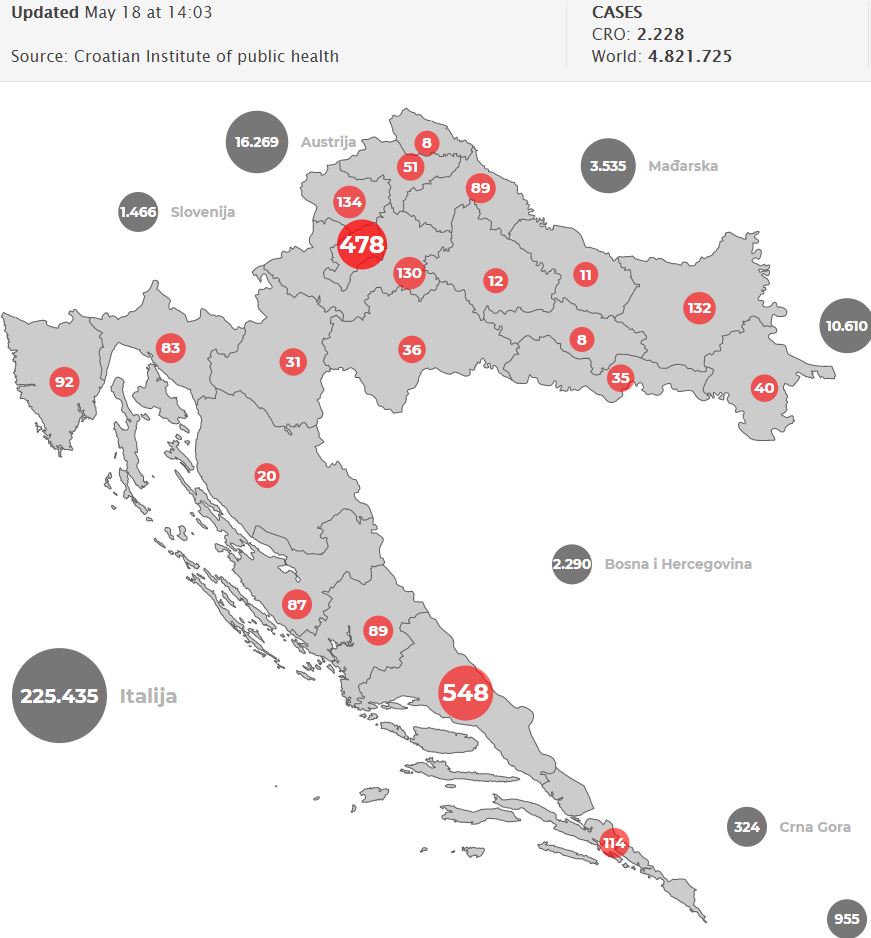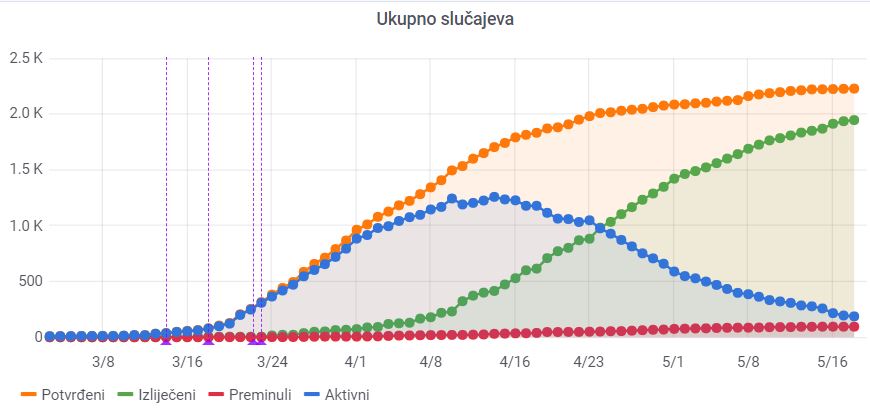TCN Launches Viber Community 'Total Croatia Travel INFO' for Latest Updates
May 19, 2020 - With so much confusion on the current travel situation AFTER CROATIA OPENED BORDERS TO TOURISTS FROM EU, TCN launches a Viber community called Total Croatia Travel INFO to keep people updated with the latest info.. All you need to follow our latest updates is to download Viber application to your mobile or desktop. Join us!
My daughters are laughing at me again.
And I will confess I do look a little ridiculous.
And old.

As the Kings of Accidental Tourism continue their strategy of waiting for tourism to happen, as our heroic minister spouts catching corona-era slogans such as Croatia Breathes Tourism, more and more people are getting confused by the lack of information officially. Simple questions such as who can cross the border, what is the procedure, where to find information about bus travel etc. A million questions.
Six days after the Deputy Minister of Tourism invited me to send the ministry questions so that a useful info page could be produced for tourists, I am still waiting for answers.
So, time for a change of course. I have spoken to various people who are connected to the latest information, and we have all the contact details of the relevant ministries. So we have decided to launch a Viber community, Total Croatia Travel INFO, where we will be posting the latest information that we have.
We are also opening the community up to questions, so if you have any questions, you can post them in the group. If we know the answer, we will provide it to for you. If not, we will give you the contact details of the relevant ministry or official body you need to speak to.
Please send this link to your friends and family interested in coming to Croatia so they also can join the community.
This idea all happened very quickly after Kreso Macan took me to the Slovenian border on Sunday. 48 hours later, and I find myself in the Manjgura conference room with two VERY smart young interns learning how to build a Viber community.
I am officially old, and I can see that I will be needing my daughters' help a lot this summer.
Join the group, help make the information better. The group is called Total Croatia Travel INFO and it was created this morning, and it is still waiting for Verified Account status. But you can find an invitation to the group here. Please check you have Viber installed on your mobiile or desktop and here is the invitation to our Croatian travel info community. Please distribute to everybody interested.
Click here for the TCN latest Croatia Coronavirus Travel, Tourism, Flights & Borders Update.
This is the first step in the Battle of Big Data and Technology v Uhljebistan.
Thanks for your support. Together we can make Croatia a better place.
Croatia Coronavirus Travel, Tourism, Flights & Borders Update May 19, 2020
UPDATE - CLICK HERE FOR THE MAY 20 OVERVIEW
May 19, 2020 - So what is the latest Croatia coronavirus travel advice? When will borders open, flights take off, and tourism finally begin? An overview of what we know at the moment.
Can you travel to Croatia? Around Croatia? Is Croatia safer than other destinations? When will tourism start? Who can cross the border?
With so many questions, so much uncertainty, and SO many people wanting to go on holiday and get tourism started, here is what we know today.
BORDER UPDATE on Slovenian border from our colleagues at Total Slovenia News
Coronavirus: Slovenia Ends All Border Restrictions with Croatia, But Not Vice Versa
TCN has also started a Total Croatia Travel INFO group where you can find all the latest information, as well as ask questions.
Official Websites, and Why TCN Thinks Lack of Information is a Deliberate Policy
The national tourist board has a page called Coronavirus 2019 nCoV Q&A.
Ministry of Tourism COVID-19 travel page.
Official government corona website.
Please be advised that all the information on this page has been compiled voluntarily from people in the private sector. This is both a disclaimer and reminder that TCN does its best to provide accurate information with limited resources, and you should contact official sources for 100% confirmation - links above. The reason TCN even started these travel updates was because those whose job it is to provide this info service were simply not doing their jobs. We have conducted an awareness campaign of just how bad the information was in the Croatian media. And with some success. The Ministry of Tourism can no longer be contacted by fax, and they have decided to put email contact details instead of fax numbers. Meanwhile, the Croatian National Tourist Board has upgraded from obscure references to the Official Gazette in favour of telling people what the current situation is. The first link above is the most useful and is being updated.
At the request of the Deputy Minister of Tourism 6 days ago, I sent a list of 14 questions our readers were asking, so that we could create a conclusive information page on the Ministry website and TCN. Six days later, no answers, despite me speaking directly to the Deputy Minister on Friday who promised we would receive one.
This policy of non-information is deliberate I think, and I explained why in Croatian Tragedies: Health v Economy, Politics v Tourism
Croatia corona travel - how safe is Croatia and how well has it handled the corona crisis?
Croatia has handled the health threat from coronavirus extremely well, both in terms of measures taken and communication. The authorities reacted quicker than most as they watched the horror unfold across the Adriatic in Italy, and an extremely effective National Civil Protection Headquarters has kept infections and deaths well below the European average. And this despite the additional challenges brought on by the Zagreb earthquakes.
(Source - Koronavirus.hr)
Croatia currently has 2,228 cases of infection, which has resulted in 95 deaths. The majority of cases - 1,946 - have recovered.
The authorities also moved quickly not only to close borders, but also to localise infection by severely restricting all unnecessary travel between municipalities. Its famous tourist islands have remained almost totally corona-free. Only those with an island ID were permitted to use the ferries, and only then with a special purpose.
(Source Velebit.ai)
So in terms of its approach to the virus, and the results, there is perhaps nowhere better than Croatia.
And then question on everyone's lips is - when can we travel to Croatia, and is Croatia corona travel safe?
Nothing is totally safe in these very uncertain times, but I would say that COMPARATIVELY speaking, Croatia is as safe as anywhere in Europe to come for a holiday IF conditions allow. More on that below.
What is the current situation with Croatia's borders? Who can enter the country?
- at Bregana and Macelj (with Slovenia);
- at Goričan and Duboševica (with Hungary);
- at Nova Sela, Stara Gradiška and Slavonski Šamac (with Bosnia and Herzegovina);
- at Bajakovo (with Serbia).
- use motorways only;
- during breaks keep distance between You and other people;
- obey the rules of Civil protection or police officers.
- at Goričan border crossing, detour: Goričan junction-ŽC2026-DC3;
- at Dvor and Vitaljina border crossings - open only to passenger traffic;
- at Gunja border crossing - there is a traffic ban on freight vehicles and buses.
Due to traffic bans on freight vehicles in Slovenia long delays should be expected in freight traffic at Bregana/Obrežje and Macelj/Gruškovje border crossings starting 1 June.
What is the reality on the ground? Here was my experience after I visited the main Bregana crossing near Zagreb, which borders Slovenia on May 17.
Key takeaways were that EU citizens can enter, but only with an official invitiation, proof of ownership of property in Croatia, or accommodation reservation. The crossing procedure currently takes 5-8 minutes. This is because in addition to checking your passport, they are manually adding all the details about your stay into the system. This is so that they can contact you in case of an outbreak of corona. By knowing where you are staying, they can monitor the situation. This is why I THINK (but please check with official sources), you can't just go anywhere without informing them in advance. They can only track a finite number of people, and that (I think) will be the number of people who will come in. All EU countries can now visit. If one million did tomorrow, they would not be able to track everything. This is a very sensible approach, keeping people as safe as possible. It is just executed in a terrible way, and there is a much better and more transparent solution.
Not everyone was allowed to cross the border. Examples of those who were turned away: a local from a Slovenian village going to meet his mistress for lunch (yes really). No official invitation, no entry. Two Slovenian ladies looking forward to seeing the Adriatic but not yet decided where to go. No reservation, no entry. And there was a LOT of discussion before a man from Munich (15 mins) was allowed to cross. His business invitation consisted of just an email. My advice having seen the border up close - make sure your invitation is as official as possible, they do seem to love their stamps, and contact the authorities before you travel on the email above.
What is the latest news about the borders opening for tourism?
Everyone WANTS tourism to begin, but just how safe is it, when might it happen, and will it be for everyone?
From the Ministry of Tourism website:
Big interest in opening borders, says tourism minister
Croatian, Italian tourism ministers discuss plans for tourism
Hotels and camps in Istria to open May 11
Minister says talks on cross-border travel underway (May 4)
Some clues from some recent TCN articles:
Croatian Tragedies: Health v Economy, Politics v Tourism
Who Can Cross the Croatia Slovenia Border? Who Cannot? A May 17, 2020 Border Visit
Socially Distanced Summer in Croatia: Rules for Beaches Published (May 16)
Restrictions for Travel across Slovenia-Croatia Border Relaxed for EU Citizens (May 15)
Police Director: About 2,700 Foreigners Entered Croatia since May 9 (May 15)
Bozinovic: Third-County Nationals Banned from Entering EU until June 15 (May 14)
Tourism Minister Gari Cappelli Reveals New Slogan for Tourists Coming to Croatia (May 14)
Tourism Minister Gari Cappelli Reveals When Croatian Borders Will Open (May 13)
Are Croatian Borders Open? Who Can Enter? What Conditions? Are There Flights? (May 13)
Trip Report of Belgian National to Hvar by Car on May 7-8, 2020 (May 9)
Source Claims Croatia Could Reopen Borders Incrementally in June (May 8)
Croatian Tourism: Dubrovnik Seeks Special Flight Arrangements (May 5)
Any Hope for Croatian Tourist Season? We're Neighbours' First Choice (May 4)
Gari Cappelli and Slovenia Optimistic about Opening Borders between Two Countries (April 30)
EU Ministers Meet: COVID-19 Passport, Cro Card and More (April 28)
Istria County Tourism Committee Hosts First Session about Opening Borders (April 28)
COVID-19 in Croatia: Gari Cappelli Discusses Summer Travel with EU Tourism Ministers (April 28)
Austrian Media: Croatia is Our Best Chance for Summer Holiday (April 27)
German Bild on Croatia: Corona-Free Destination for Summer Travel (April 25)
What about flights to Croatia? An overview of all the major airlines to Croatia and their current positions
If there is one tiny cloud with a silver lining for Croatian tourism, it is that the vast majority of its visitors arrive by car. The proximity of countries such as Slovenia, Austria, Germany, Poland, Czechia, Slovakia, Hungary and Serbia mean that the season will not be a total disaster if it is allowed to start. Holiday options for these countries will be more limited due to the drastic reduction in flights which will be a post-corona reality. So destinations such as Greece, Turkey and Egypt will be much harder to reach than hopping in a car from Central or Eastern Europe.
You can read some detailed analysis of the Croatian aviation market in the future from Max Oldorf, COO of ch-aviation in this TCN interview this recently:
Flights to Croatia Post-Corona: Overview with Max Oldorf, COO of ch-aviation
The big intercontinental carriers have mostly written off 2020 totally, with Qatar Airways and American Airlines, delaying Dubrovnik until 2021. And with the CEO of easyJet saying the airline will feel like a new startup post-corona, Ryanair's homepage focusing on September breaks since March, and Norwegian Air on the brink, the reality is that flights to Croatia will be much reduced. The official Koronavirus website has produced this very helpful overview of where individual airlines are with their plans. You can follow the updated page here.
CROATIA
From May 4, 2020, it is mandatory to use face masks / headgear on all Croatia Airlines flights. Passengers on all Croatia Airlines flights are required to bring and wear face masks or covers. Masks must be worn throughout the stay in the cabin of the aircraft.
Acceptable face covers:
two-layer cotton face masks
medical (surgical) face masks
filter half masks with and without valve (FFP2 / N95)
CA contact center: 0800 77 77 (free calls from Croatia), 072 500 505 or +385 1 66 76 555. For more details see the link.
Dubrovnik Airport - From 11.05.2020, domestic air traffic on the route Zagreb - Dubrovnik - Zagreb is re-established. Croatia Airlines will operate two flights a day. More details.
Osijek Airport - from 27.4. the Pothodnik branch reopens. While prevention measures are in place, the opening hours will be 9 am-5pm on weekdays (Monday through Friday). More information can be obtained by e-mail This email address is being protected from spambots. You need JavaScript enabled to view it. and phone +38531284611. It is recommended that all inquiries be sent in writing to the specified e-mail. More information.
Rijeka Airport - latest info here.
Zagreb Airport - latest info here.
The Croatia Airlines contact center is available on the following numbers: 0800 77 77 (toll free calls from Croatia), 072 500 505 or +385 1 66 76 555. More info.
AirBaltic - All AirBaltic connections are suspended from March 17 to May 17, 2020. Click for the latest info.
Air France - From May 11, masks are mandatory on flights. Due to coronavirus, they have reduced 90% of flight capacity and this supply reduction is in effect until the end of May. Due to the closure of Paris-Orly Airport, all flights from and to Paris go via Paris-Charles de Gaulle Airport. Latest info.
Air Canada has suspended all flights between Toronto and Zagreb for the summer of 2020.
Austrian Airlines, a branch of Lufthansa, has decided to suspend all its scheduled flights until the end of May 2020. More details.
British Airways - the latest updates.
Brussels Airlines has decided to suspend flights until May 15, 2020. More details.
Czech Airlines - Masks are mandatory on flights. More details on flight plans.
easyJet - They made the decision to ground the aircraft until further notice. More details.
Emirates - Emirates has established limited passenger flights to transport passengers departing from the UAE. More details.
Germanwings - Germanwings flights no longer exist.
KLM - Latest info.
Lufthansa - More details.
Ryanair - As most EU countries have imposed flight bans or other restrictions, more than 90% of Ryanair's aircraft are grounded, and the limited flight schedule has been extended until 28 May. More details.
Turkish Airlines - All international flights are canceled until May 28, 2020. More details.
Qatar Airways - all direct flights between Zagreb and Doha are suspended until May 31, 2020. Flexible when changing travel plans until September 30, 2020. For more information, contact the Qatar Airways office in Zagreb at +385 (0) 1 4961110 / 111, email: This email address is being protected from spambots. You need JavaScript enabled to view it. or check the details here.
Wizz Air - In early May, it will fly from Budapest to Athens, Barcelona, Berlin, Birmingham, Basel, Dortmund, Eindhoven, Gothenburg, London, Liverpool, Madrid, Podgorica, Sarajevo, Stockholm and Targa Mures. See more here.
All this flight info above is official information. Below some TCN articles which cover various aspects of flight news.
Flights to Croatia Post-Corona: Overview with Max Oldorf, COO of ch-aviation
Ryanair Significantly Reduces Summer Routes to Croatia (May 18)
Is Eurowings Returning to Croatia this Summer? (May 16)
Croatia Airlines Already Beginning to Reduce Number of Flights (May 16)
Hope for 2021? American Airlines Dubrovnik - Philadelphia Loaded for June 4, 2021 (May 14)
CEO Eddie Wilson: Ryanair Zadar Base Will Not Go Ahead (May 13)
Ryanair to Croatia Planned for July: Zadar, Split, Dubrovnik, Rijeka, Pula Flight Info (May 12)
British Airways Will Fly to Zagreb and Split from June (May 12)
Flights to Croatia: Korean Air Cancels Seasonal Zagreb Service, Air Transat Delayed (May 9)
What about freedom of movement within Croatia at the moment?
Currently, as far as I know, Croatia is totally open, with the exception of Brac, which had an outbreak of infections and was placed under 14-day quarantine. No new cases have been reported on Brac in recent days.
Recommendations and instructions for tourists entering Croatia
Recommendations and instructions of the Croatian Institute of Public Health for Croatian and foreign nationals who are crossing the state border and entering the Republic of Croatia. Official guidelines (May 9)
What is the situation with ferries in Croatia?
Ferries are now operating more of less normally, with coastal lines restored yesterday.
Public Coastal Liner Transport to be Restored on May 18
From the HAK website - you can check the latest here:
Dubrovnik-Korčula-Hvar-Bol and Split-Hvar ferries do not operate till 19 June.
On the line Zadar-Ancona operates Marko Polo ship, according to its timetable, still for freight vehicles only.
Sumartin-Makarska ferry does not operate, on the line Supetar-Split journeys are reduced.
Till 1 June 2020 401 Zadar (Gaženica)-Ist-Olib-Silba-Premuda-Mali Lošinj ferry does not embark at Silba port due to roadworks.
Here is the timetable in full in English.
You can check the latest news in English on the Jadrolinija website.
Timetable and news from Krilo catamarans.
Are buses running between cities in Croatia?
Yes.
A really good resource from GetByBus gives you all the latest.
Also worth a read on the new realities on buses:
FlixBus Returning to Croatian Roads, Passenger Instructions Published
What about local transport?
As far as I know, local transport has now restarted. I don't have more information currently than what is in the links below, but happy to add if anyone wants to send updates to This email address is being protected from spambots. You need JavaScript enabled to view it. Subject Travel Update
New changes to the ZET tram timetable in Zagreb (May 4)
An overview of the situation in Zagreb. (April 26)
Promet Split Back in Action Monday: Bus Timetables, Tickets, and Rules (April 26)
Are there any trains currently running in Croatia?
Yes
What is the situation on Croatia's roads and motorways?
There is obviously a lot less traffic on the roads currently. For the latest information on roadworks and other problems, check this HAK page (in English)
Are taxis and private transfers available in Croatia?
Yes. I checked with one of the most reliable providers, Octopus Transfers, and they are able to cover transfers all over the country.
The situation is constantly evolving, and for the latest on travel updates and all other coronavirus developments, we recommend you follow the dedicated TCN COVID-19 section.
If there are errors or omissions in the above, please contact me at This email address is being protected from spambots. You need JavaScript enabled to view it. Subject Travel Update, so that I can get this resource updated. Thanks in advance and stay safe.
Who Can Cross the Croatia Slovenia Border? Who Cannot? A May 17, 2020 Border Visit
May 17, 2020 - In the absence of clear travel information, TCN visits the Croatia Slovenia border to find who is - and who is not - allowed to cross the border into Croatia. It was an illuminating visit.
Are Croatia's borders open or not? If yes, who can cross them, and under what circumstances? With so many tourists wanting to come, can they jump in the car and come?
After Croatia led the world in clear communication on the health aspects of the corona threat, that clarity seems a distant memory. Stories of foreign tourists entering the country are flooding the media, and it seems that the season is starting. But is it?
Here is the official COVID-19 page from the Ministry of Tourism which one would hope would provide the answer. If you can find it, you are a better man than me.
According to the Croatian National Tourist Board recently revamped travel info page, all the answers can be found at a very helpful email address. Insider tip - good luck with that one from personal experience.
Here is some useful info from Croatian Roads (HAK), but with all those specific questions resting on the Ministry of Tourism responding to an email.
I am still trying to find out the actual procedure for crossing the border. As my colleague patiently waited for the email reply (now Day 4), I concluded that there was nothing better than finding out from personal experience.
Why not go to the Croatia Slovenia border myself and see what is happening. As these are sensitive times, I contacted the Ministry of the Interior of both Croatia and Slovenia, stating my intentions and asking for their assistance.
Croatia 1, Slovenia 0.
I received an automated response from the Slovenians the next day (in Slovenian). I have heard nothing since. From the Croatian side, I received this:
Dear Sir,
we agree with the recording at the said border crossing, without statements from police officers and other officials.
Please comply with the Law on State Border Surveillance, follow the instructions of police officers and keep your stay at the border crossing to a minimum.
The same is necessary for the smooth implementation of measures and actions carried out at the border crossing.
We also confirm that we have received your inquiry sent to us on 15th of May 2020., and we inform you that we will send you an answer when we gather all the necessary information.
Best regards,
There are three border crossings just outside Zagreb around Bregana, and I decided to visit all three, the two small ones first.
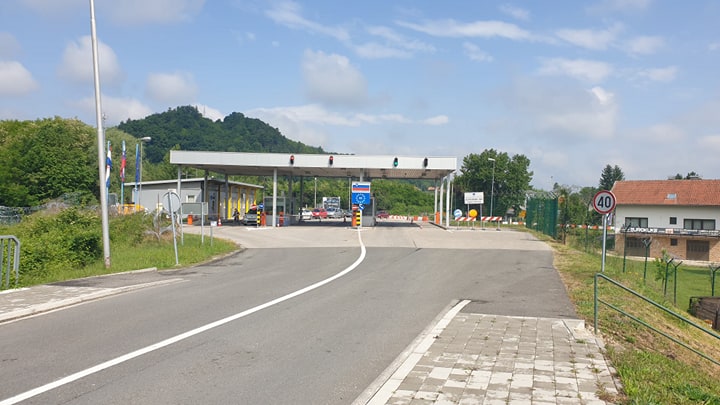
The first was quiet, with just a few cars coming from the Slovenian side. The Croatian border official was polite and let me proceed to her Slovenian colleague, who declined to answer questions as I didn't have a Slovenian official approval.
There were a couple of Slovenian bikers who were happy to talk to me. This was not their first time across the border. They had a business in the next village, all the appropriate paperwork, so the crossing was problem-free. Get the necessary paperwork, an invitation from a Croatian business, for example, and all is fine.
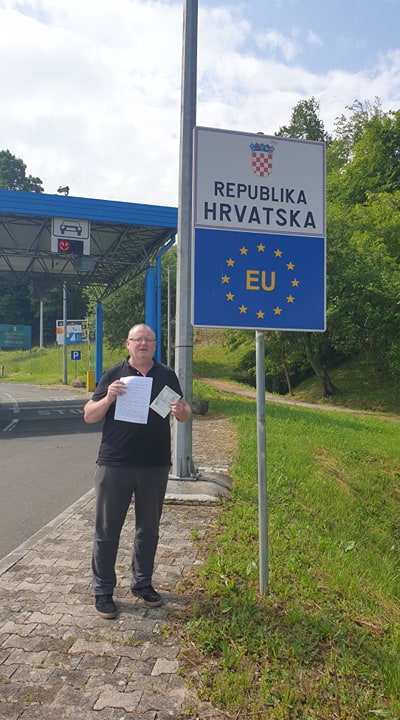
I was planning to film a video report but I now how sensitive the police are about filming at borders. Ok, true story - I left my phone charger in Dugopolje and my phone died.
I did get a copy of the recommendations (and in English!) for each tourist arriving. You can see the advice at the bottom of this article.
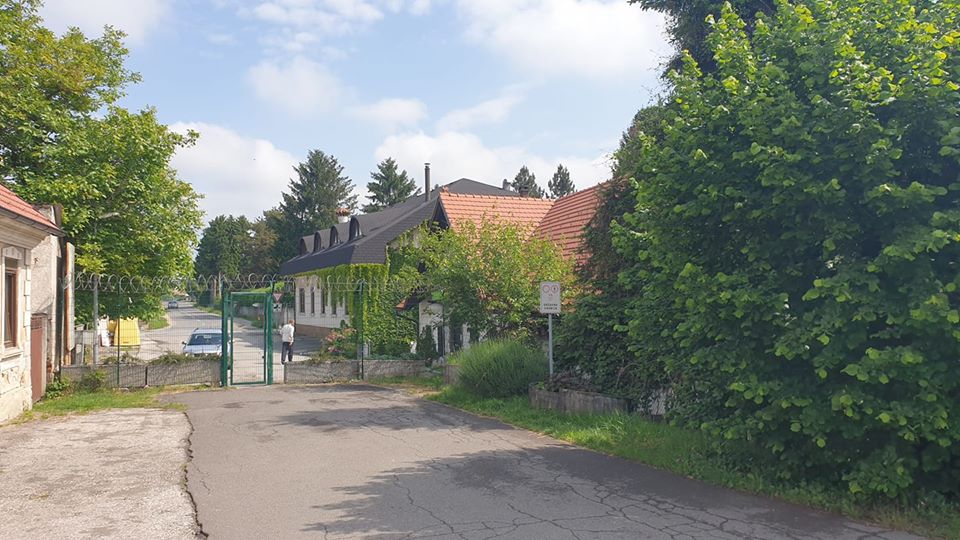
Next up, the best Croatia Slovenia border of them all (if you really want to research the subject, here is the Total Croatia guide to crossing the Croatia Slovenia border in normal times).
Before the migrant crisis, this border had one of the coolest border restaurants ever - the bar was in one country, the toilets in the other. Imagine having to leave the Schengen zone to pee!
The restaurant is now closed for normal service, but it does still service groups, the owner told us through the gate today. But the erection of the wire and gate during the migrant crisis killed all business. The border is normally open from 0600 - 2300, but has been closed these past few weeks - and remains so.
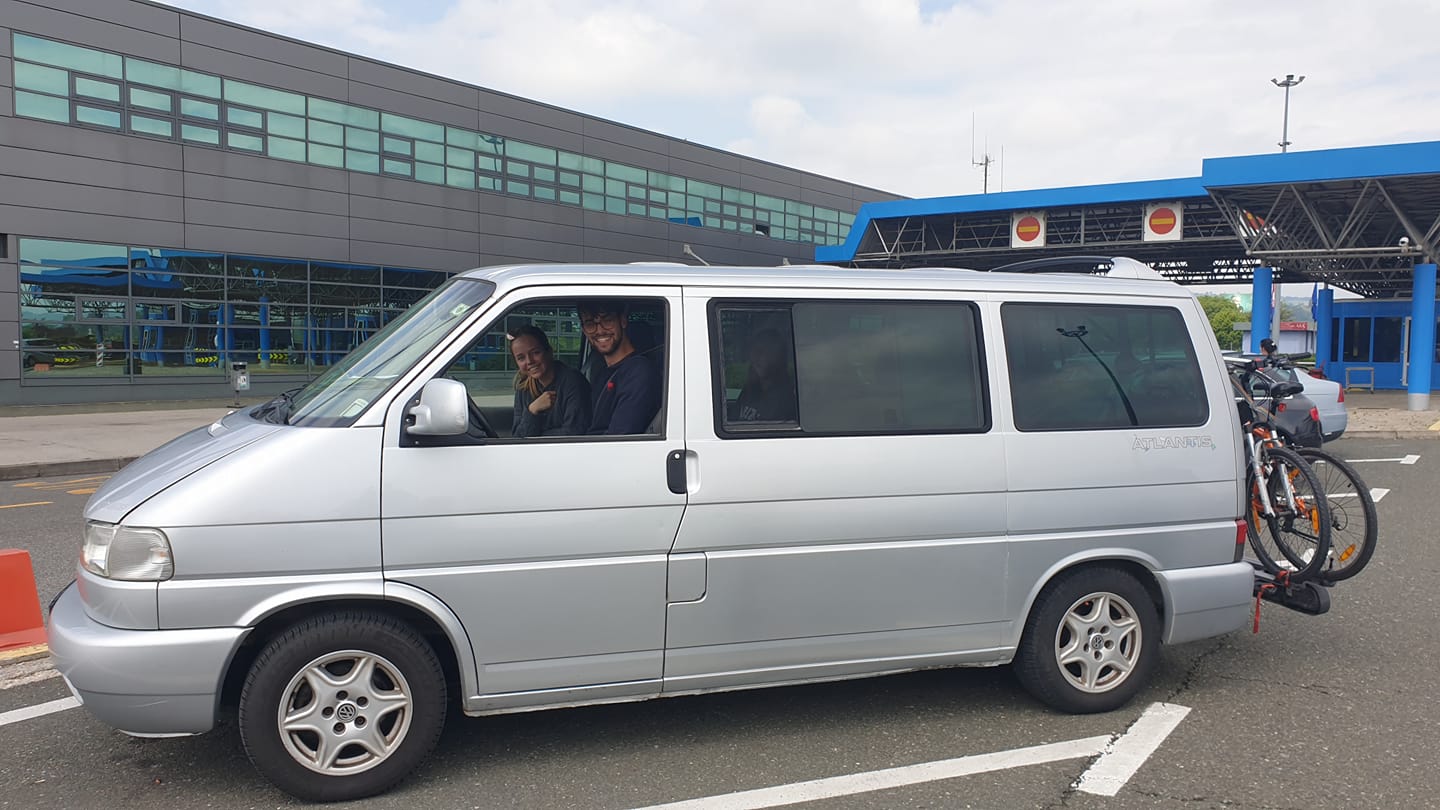
I introduced myself to the Croatian police, who were very polite, helpful and efficient. My documents checked, I was free to observe and to talk to people travelling both ways. I really liked thes happy Slovenians, who had been following the local news and got everything in place regarding paperwork. They were off to a campsite on Krk where their family had a property, and they made sure they had an official invitation, with a stamp for good measure.
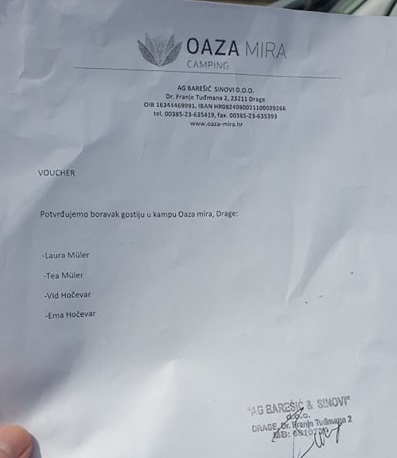
Now that the borders in Slovenia are open, they did not have to worry about self-isolation on return. This is an issue which people are asking about. Until I get official answers, all I can say is talk to your embassy about the latest info, both incoming to Croatia and when you return home. They will have the best (and official) info.
There were lots of foreign plates, mostly German, but few foreigners. The Croatian diaspora returning home from Germany, Austria, Holland. A Montenegrin living in Munich, who has been going back and forth for weeks.
Processing time was about 5 minutes per car, but this was the process that reassured me. For the word in Croatia is that the borders are open, which is great news for tourism. But it would be highly irresponsible to simply let everyone in without knowing where they are going.
And not everyone is getting in.
Currently, you can pass the border as an EU citizen if you have an official business invite, own real estate, or can prove a tourism reservation in a hotel or similar.
And if you can't, you don't come in.
The idea, I realised, is the ability to control the information in case of trouble.
The transit process (and PLEASE note, this is just the Croatian border, I did not get permission for the Slovenian one, is that you can rock up at the border, show your ID and certified reservation or business invite, or real estate papers, and be allowed in. They will want to know how long you will stay, address and your contact details, as well as physically showing your invitation. The registration process is a swipe of your ID, but then the time-consuming process of manually adding details of your invitation, contact details etc. Necessary but time-consuming.
By controlling the whereabouts of tourists who enter, it seems, this is how Croatia will control the corona threat. And not everyone gets in...
My favourite moment was the pre-crossing chat with a Slovenian guy from a local town. He winked and told me he was off to see his Croatian mistress for lunch and a bit of fun. Unfortunately, his illicit lover was left a little frustrated, as they both forgot to sort the official invite (presumably the wife might have found out). No entry.
Two very jolly Slovenian ladies of a certain age were thrilled to be able to get to their beloved Adriatic. They had no plans, the borders were open and they would decide where when they felt like it. No entry.
A Croat from Germany with a business meeting to attend in Zagreb. The invite consisted of an email. After a long discussion (and some phone calls), he was allowed through. Lesson learned and top recommendation - get a proper, stamped invitation. It will save time for you and all behind you, and will eliminate the risk of refusal.
And that's as much as I can tell you, as someone not part of the system.
Check before you travel, make sure you have the documentation ready, and you should be fine.
Recommendations and instructions of the Croatian Institute of Public Health.
Croatian and foreign nationals entering the Republic of Croatia must comply with these recommendations and instructions in the period of 14 days following their crossing of the state border, as follows:
During the first 14 days following the entry into the Republic of Croatia, accommodation may be left only in absolutely necessary situations:
carrying out business activities if business was the purpose of entry into the Republic of Croatia, carrying out necessary activities with continuous increased hygiene measures in place.
When leaving accommodation in absolutely necessary situations, it is recommended to wear a mask or a covering for the nose and mouth, to keep a physical distance from others (a minimum of 1.5 meters) and to practice hand hygiene.
Hands should be washed as often as possible with warm water and soap and/or a hand disinfectant should be used that needs to be well rubbed on the palms.
Touching one's face, mouth, nose and eyes should be avoided.
Using public transport should be avoided.
ln the means of transport, a person should preferably be alone or exclusively with persons with whom he/she shares accommodation.
Grouping and public gatherings should be consistently avoided.
During business meetings, it is necessary to meet with as few persons as possible, to ensure a physical distance of 1.5 meters and availability of disinfectants, to avoid unnecessary meetings.
During their stay in the accommodation, the persons concerned prepare the food themselves or use food and beverage delivery services.
Payments are made by using non-cash card payments or online services.
Body temperature should be measured every morning. lf it exceeds 37.2 degrees, it should be taken again after 10 minutes. lf the temperature again exceeds 37.2 degrees, the person should stay at home/one's accommodation and contact the chosen general practitioner,
if any (Croatian nationals), or a competent local epidemiologist.
ln case of any symptoms of acute respiratory infection (cough, sore throat, high temperature, short breath/difficulty in breathing, loss of smell and taste), it is necessary to stay at home/your accommodation and contact the chosen general practitioner, if any (Croatian nationals), or a competent local epidemiologist.
ln case of sudden onset of severe, life-threatening symptoms, the person should contact the emergency medical services.
ln case of respiratory disease symptoms.
lf you develop respiratory disease symptoms (high temperature, cough, shortness of breath, difficulty in breathing, sore throat, weakness), you should contact your chosen doctor by phone who will, based on your medical condition, assess the need for you to be tested for the new coronavirus.
lf you require medical assistance for reasons other than a respiratory disease, you should phone your chosen doctor or one of the members of your household can contact the doctor for consultations and arranging a house call.
Do not visit healthcare facilities without having previously contacted them by phone.
You can find more information on the coronavirus disease and measures for reducing the risk of spreading the disease on the website of the Croatian Institute of Public Health, or from your chosen general practitioner and a competent local epidemiologist.
Croatia Travel Update March 20, 2020: Flights, Ferries, Borders, Self-Isolation
MARCH 23, 2020 CROATIA TRAVEL UPDATE
March 20, 2020 - As the coronavirus dominates, a Croatia travel update on flights, ferries, trains, buses, borders and self-isolation.
Things are changing very quickly as the coronavirus crisis escalates in Europe. A Croatia travel update on what is - and is not - open or running.
Croatia Travel Update: Are the borders of Croatia open?
This is the latest official information from HAK on the situation at the borders of Croatia. For the latest information (in English), check out the HAK website.
Transit passengers information, if travelling through Republic of Croatia:
- use motorways only;
- use the following rest areas only: Novska jug, Novska sjever, Kozjak jug, Prokljan sjever, Draganić sjever, Draganić jug, Bačva and Ravna Gora;
- during breaks keep distance between You and other people;
- obey the rules of Civil protection or police officers.
At all border crossings with Croatia inbound traffic is allowed only to Croatian citizens (14-day isolation mandatory) as well as for some special groups of people, such as medical personnel, scientists, eldercare personnel, cross-border workers, freight traffic, diplomats, police officers, civil protection teams, international organizations members, militaries and transit passengers.
At the border crossings with Hungary, Serbia and Montenegro traffic is suspended for all vehicles, except for the citizens of these countries as well as for freight vehicles.
At Bogojevo (Erdut) border crossing all passenger traffic is closed.
Traffic is closed at the following border crossings:
- at Goričan border crossing, detour: Goričan junction-ŽC2026-DC3;
- at Dvor and Vitaljina border crossings - open only to passenger traffic;
- at Gunja border crossing - there is a traffic ban on freight vehicles and buses.
Due to traffic bans on freight vehicles in Slovenia long delays should be expected in freight traffic at Bregana/Obrežje and Macelj/Gruškovje border crossings starting 1 June.
Croatia Travel Update: Are the ferries in Croatia running normally?
Domestic ferries are running as normal. This is the latest update from HAK:
807 Dubrovnik-Koločep-Lopud-Suđurađ ship does not operate from 2pm till 4.30pm.
Split-Ancona international line does not operate till 1 April, Dubrovnik-Bari till 19 April 2020.
Other ferries operate regularly.
Till 1 June 2020 401 Zadar (Gaženica)-Ist-Olib-Silba-Premuda-Mali Lošinj ferry does not embark at Silba port due to roadworks.
As reported earlier on TCN, Jadrolinija is now requesting that passengers make their ticket purchases online or via their app.
You can check the latest from Jadrolinija on their website.
Croatia Travel Update: What is the situation with train travel in Croatia?
The latest HAK update on the railways:
All information about changes in schedule made due to COVID-19 regarding Croatian and international railway traffic you can get here.
Due to repair work passengers are transported by buses so delays are possible on the following sections:
- between Dugo Selo and Križevci railway stations (on the rail state border-Botovo-Dugo Selo)
- between Zaprešić and Zabok railway stations (on the rail Zaprešić-Čakovec)
- between Sunja and Sisak Caprag railway stations (on the rail Zagreb-Sisak-Novska)
- between Ogulin and Moravice railway stations (on the rail Zagreb-Rijeka).
International railway traffic:
Railway traffic is suspended towards Slovenia, Austria, Germany, Switzerland, Serbia and Hungary.
Croatia Travel Update: What is the situation with flights to Croatia?
The closing of the EU external borders took effect today, a measure that will last for 30 days. As such, all international flights outside EU borders have now been cancelled. There are still flights to Zagreb within EU borders, and so there is not a total flight ban, as ExYuAviation noted a few days ago:
The EU travel will only partially affect Croatia. Under the plan, only visitors from non-EU states will not be allowed to enter the region unless they are long-term residents of the EU, family members of EU nationals, diplomats, cross-border commuters, or essential workers like doctors, nurses, and researchers. The majority of Croatia Airlines’ network is concentrated within the EU, however, plummeting demand and various national restrictions will see the carrier cancel at least nine return flights today, among which are services to cities outside of the block such as Sarajevo and Skopje. Furthermore, flights from Zagreb to Copenhagen, Vienna and Munich have also been cancelled so far today. Despite the new circumstances, Aeroflot, Turkish Airlines and Qatar Airways will operate their flights to the Croatian capital today.
HOWEVER, checking the Zagreb airport departures page today, there were two non-EU flights which appeared to depart - Croatia Airlines to Sarajevo, and Qatar Airways to Doha. Here is the Zagreb Airport departures page for the latest info. Contact your airline for the latest news regarding your flight.
Croatia Airlines also have a dedicated information page on which of their flights are going, as well as flight cancellations.
Internal flights within Croatia remain available, as do some to other EU countries. Dubrovnik Airport is closed, however, due to a coronavirus infection. You can see which internal flights are available from Split here - all international flights to the coast have stopped.
We have had a LOT of emails asking what will happen with flight cancellations, and will things be ok in May, June and beyond. Obviously, we have no idea how things will develop. With the 30-day international ban, most flights are already cancelled. We hope the situation will improve, but recommend you check with your individual airline, who will be better informed than us. If there are any major announcements, we will publish them on TCN. Please do not contact us with individual queries about your flight, as we have limited resources currently and are unable to help more than this update.
READER INFO UPDATE (added after publication)
A booking was made today (Friday) for travel starting from Split on Sunday by US citizen to US.
Sunday: Separate domestic leg SPU-ZAG.Monday, from Zagreb: ZAG-BRU-EWR (Newark, NJ). United Airlines.
Croatia Travel Update: Are buses running in Croatia?
Yes they are, but at reduced capacity in many cases. I don't have a good resource for national information (if anyone does, please contact me at This email address is being protected from spambots. You need JavaScript enabled to view it. and I will add). One of the biggest operators, Croatia Bus, stopped all routes temporarily due to COVID-19 (source Zagreb Bus Station Facebook page).

Zagreb Bus Station has published a number to call - 072 500 400 - to check if your bus is running.
In other more localised bus news by TCN, there is free local bus travel in Dubrovnik, and here is a recent update from Split bus station.
Please note that the issue of restricting internal travel has been raised, as part of the strategy to contain the virus, so it could well happy soon that there are few, is any, buses available.
Croatia Travel Update: What are the self-isolation rules for people arriving, who do they apply to, and what is the procedure?
There has been a lot of confusion about the mandatory 14-day self-isolation requirements, what they entail and how they are enforced, as well as who they apply to. I am very grateful to Lauren Simmonds for this excellent overview, having contacted and worked through various sources of conflicting information. Check out Lauren's guide to self-isolation in Croatia here.
The Croatian Government has launched a new information website to coordinate all information about coronavirus in Croatia, called Koronavirus.hr. This includes a page (in Croatian - Google Translate is your friend) called Going on a Trip?
If you have any reliable information to improve the resource above, please contact me on This email address is being protected from spambots. You need JavaScript enabled to view it. and I will update if relevant.
For the latest on the coronavirus crisis in Croatia, follow the dedicated TCN section.
Stay safe!
How Many Islands Does Croatia Have?
September 19, 2020 - A country of 1000 islands actually has quite a bit more... but how many are there exactly?
You'll often see Croatia promoted as the country of a thousand islands. It always seemed like a pragmatic approach - there are more than 1000, of course, but such a rounded number has a certain sleek appeal to it. It sounds way better than, say, a country of 1244 islands. That just looks like an opening line to a math problem.
Marketing aside, how many islands does Croatia actually have? It turns out, a consensus on that particular topic hasn't yet been reached. Several entities have their own individual opinions on the exact number and they all seem to differ, so we end up hearing about a new version every so often, leaving both us locals and tourists confused.
The Croatian National Tourist Board has occasionally cited the mentioned number of 1244 in their promotional campaigns. The fact was confirmed by the Ministry of Tourism; in 2010, they referred to the figure as the latest data collected by the Hydrographic Institute of the Republic of Croatia (HHI). And yet, as stated in this report by Jutarnji, experts from the Cartographic Department of the Hydrographic Institute said there were actually 1246.
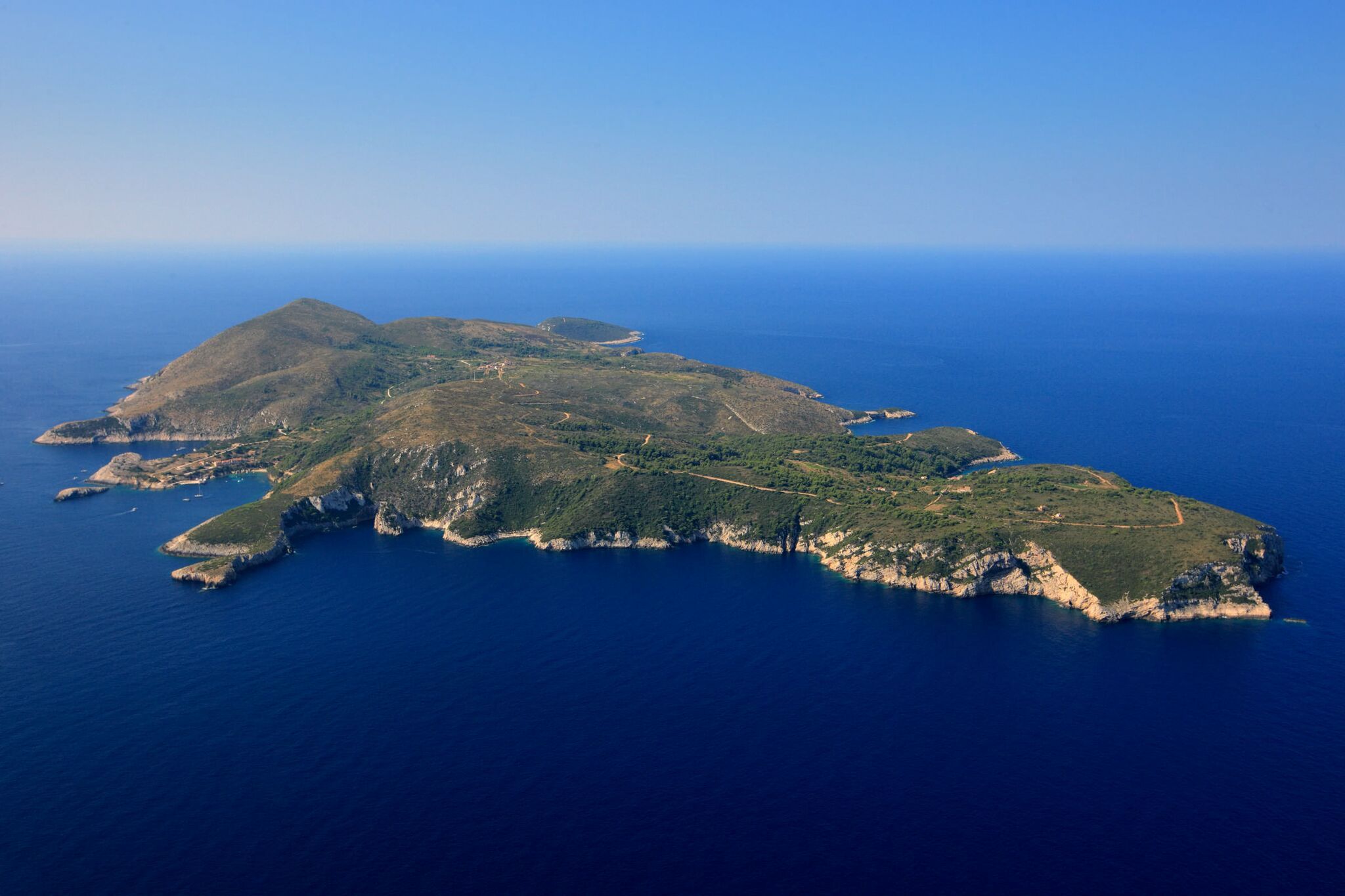
Biševo / Romulić and Stojčić
An older version of the article about Croatian islands on Wikipedia used to state there were 991; it has since been altered to cite 1244. Those who were looking up Croatian islands a decade or two ago might remember 1185 popping up here and there; this particular figure was established in the 50s and updated in the meantime owing to more refined technology. It's no wonder some people are perplexed - the best example I've come upon is a travel piece titled 'Croatia's 1244 Dalmatian islands'. We might not be sure how many there are precisely, but they certainly aren't all Dalmatian. At least one thing we can all agree on.
Where to look for the source of all the confusion? Well, the sole definition of an island is a good place to start. The Hydrographic Institute classifies every landform surrounded by water with a surface bigger than 1 km2 as an island. Those between 0.1 and 1 km2 are considered islets, and those that are smaller than 0.1 km2 are classified as rocks.
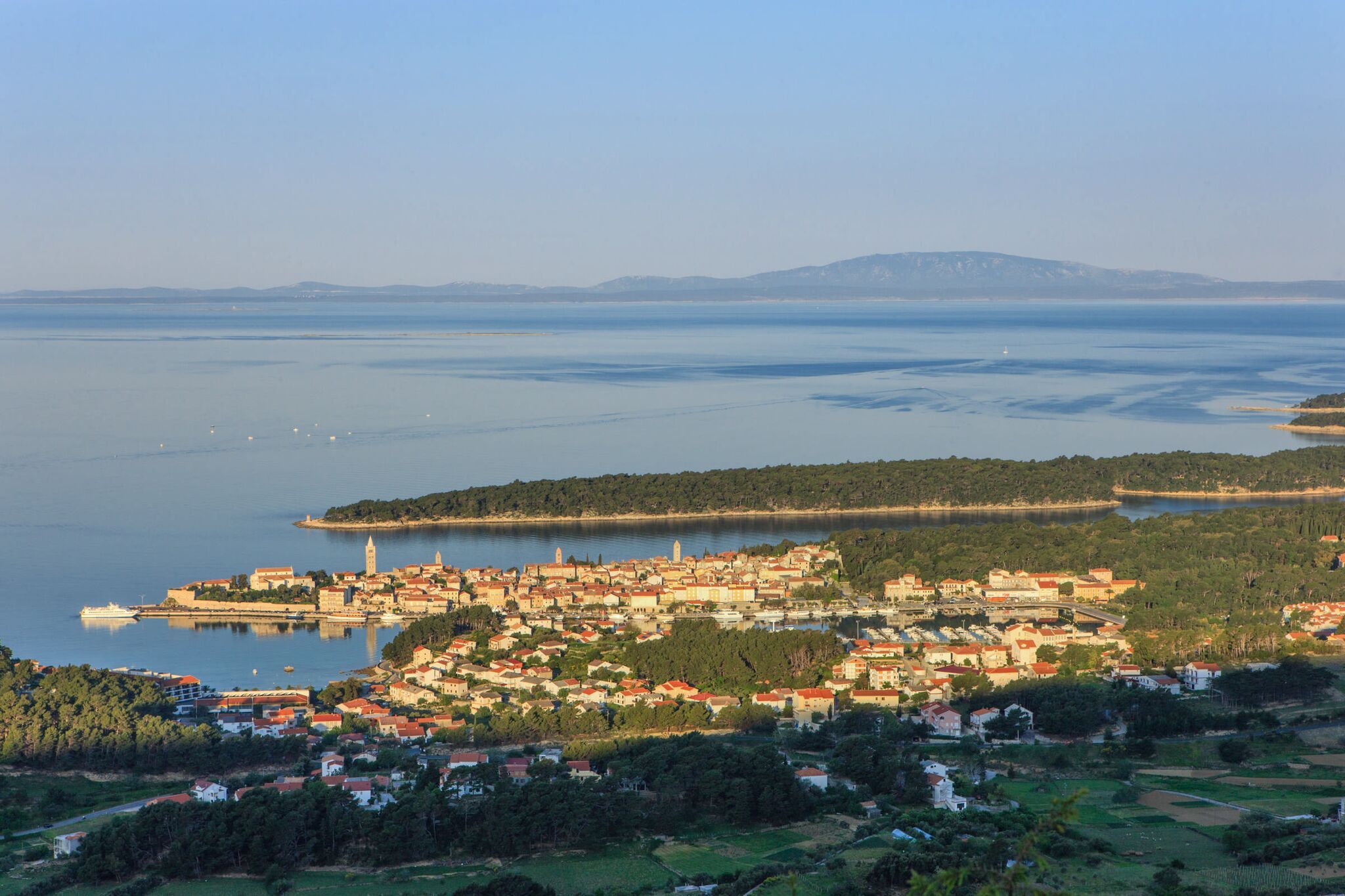
Rab / Romulić and Stojčić
Out of those 1244, only 78 are actually proper islands (or 79, depending on the source); 525 are islets, while 642 are rocks and reefs. According to an expert from the Cartographic Department quoted in Jutarnji's piece, pinpointing the exact number can be tricky. Relying on aerial views isn't always a foolproof way of establishing the size of an island, which is why some tend to end up in the wrong category, and there's not enough personnel to allow for collecting data on the ground. "We had 130 employees before the war, and now there are 85. This is why we don't have time to count the islands; we prioritise construction of nautical charts to ensure safe navigation", said Pijo Bročić from the Cartographic Department of HHI. Fair enough.
All things considered, speaking from a realistic point of view, you probably won't be losing any sleep over the exact number of rocks in Croatia. The most popular island destinations are very much alive and kicking, and they're not about to fall off the map any time soon - pun intended.
Explore the island tag on TCN for news and stories from the Adriatic coast.


